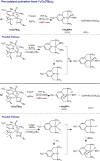Insights into Activation of Cobalt Pre-Catalysts for C(sp2)-H Functionalization
- PMID: 29456261
- PMCID: PMC5813819
- DOI: 10.1002/ijch.201700072
Insights into Activation of Cobalt Pre-Catalysts for C(sp2)-H Functionalization
Abstract
The activation of readily prepared, air-stable cobalt (II) bis(carboxylate) pre-catalysts for the functionalization of C(sp2)-H bonds has been systematically studied. With the pyridine bis(phosphine) chelate, iPrPNP, treatment of 1-(O2CtBu)2 with either B2Pin2 or HBPin generated cobalt boryl products. With the former, reduction to (iPrPNP)CoIBPin was observed while with the latter, oxidation to the cobalt(III) dihydride boryl, trans-(iPrPNP)Co(H)2BPin occurred. The catalytically inactive cobalt complex, Co[PinB(O2CtBu)2]2, accompanied formation of the cobalt-boryl products in both cases. These results demonstrate that the pre-catalyst activation from cobalt(II) bis(carboxylates), although effective and utilizes an air-stable precursor, is less efficient than activation of cobalt(I) alkyl or cobalt(III) dihydride boryl complexes, which are quantitatively converted to the catalytically relevant cobalt(I) boryl. Related cobalt(III) dihydride silyl and cobalt(I) silyl complexes were also synthesized from treatment of trans-(iPrPNP)Co(H)2BPin and (iPrPNP)CoPh with HSi(OEt)3, respectively. No catalytic silylation of arenes was observed with either complex likely due to the kinetic preference for reversible C-H reductive elimination rather than product- forming C-Si bond formation from cobalt(III). Syntheses of the cobalt(II) bis(carboxylate) and cobalt(I) alkyl of iPrPONOP, a pincer where the methylene spacers have been replaced by oxygen atoms, were unsuccessful due to deleterious P-O bond cleavage of the pincer. Despite their structural similarity, the rich catalytic chemistry of iPrPNP was not translated to iPrPONOP due to the inability to access stable cobalt precursors as a result of ligand decomposition via P-O bond cleavage.
Keywords: C–H activation; PNP ligand; PONOP ligand; borylation; cobalt.
Figures








References
-
- Godula K, Sames D. Science. 2006;312:67–72. - PubMed
- Rouquet G, Chatani N. Angew Chem Int Ed. 2013;52:11726–11743. - PubMed
- McMurray L, O’Hara F, Gaunt M. Chem Soc Rev. 2011;40:1885–1898. - PubMed
- Gutekunst WR, Baran PS. Chem Soc Rev. 2011;40:1976–1991. - PubMed
- Colby DA, Tsai AS, Bergman RG, Ellman JA. Acc Chem Res. 2012;45:814–825. - PMC - PubMed
-
- Iverson CN, Smith MR. J Am Chem Soc. 1999;121:7696–7697.
- Cho JY, Tse MK, Holmes D, Maleczka RE, Smith MR. Science. 2002;295:305–308. - PubMed
- Ishiyama T, Takagi J, Ishida K, Miyaura N, Anastasi NR, Hartwig JF. J Am Chem Soc. 2002;124:390–391. - PubMed
- Ishiyama T, Takagi J, Hartwig JF, Miyaura N. Angew Chem Int Ed. 2002;41:3056–3058. - PubMed
-
- Hall DG. Boronic Acids. Wiley-VCH; Weinheim: 2005.
-
- Mazzacano TJ, Mankad NP. J Am Chem Soc. 2013;135:17258–17261. - PubMed
- Hatanaka T, Ohki Y, Tatsumi K. Chem – Asian J. 2010;5:1657–1666. - PubMed
- Dombray T, Werncke CG, Jiang S, Grellier M, Vendier L, Bontemps S, Sortais JB, Sabo-Etienne S, Darcel C. J Am Chem Soc. 2015;137:4062–4065. - PubMed
- Yan G, Jiang Y, Kuang C, Wang S, Liu H, Zhang Y, Wang J. Chem Commun. 2010;46:3170–3172. - PubMed
-
- Obligacion JV, Semproni SP, Chirik PJ. J Am Chem Soc. 2014;136:4133–4136. - PubMed
- Schaefer BA, Margulieux GW, Small BL, Chirik PJ. Organometallics. 2015;34:1307–1320.
- Scheuermann ML, Johnson EJ, Chirik PJ. Org Lett. 2015;17:2716–2719. - PubMed
- Léonard NG, Bezdek MJ, Chirik PJ. Organometallics. 2017;36:142–150.
Grants and funding
LinkOut - more resources
Full Text Sources
Other Literature Sources
Miscellaneous
